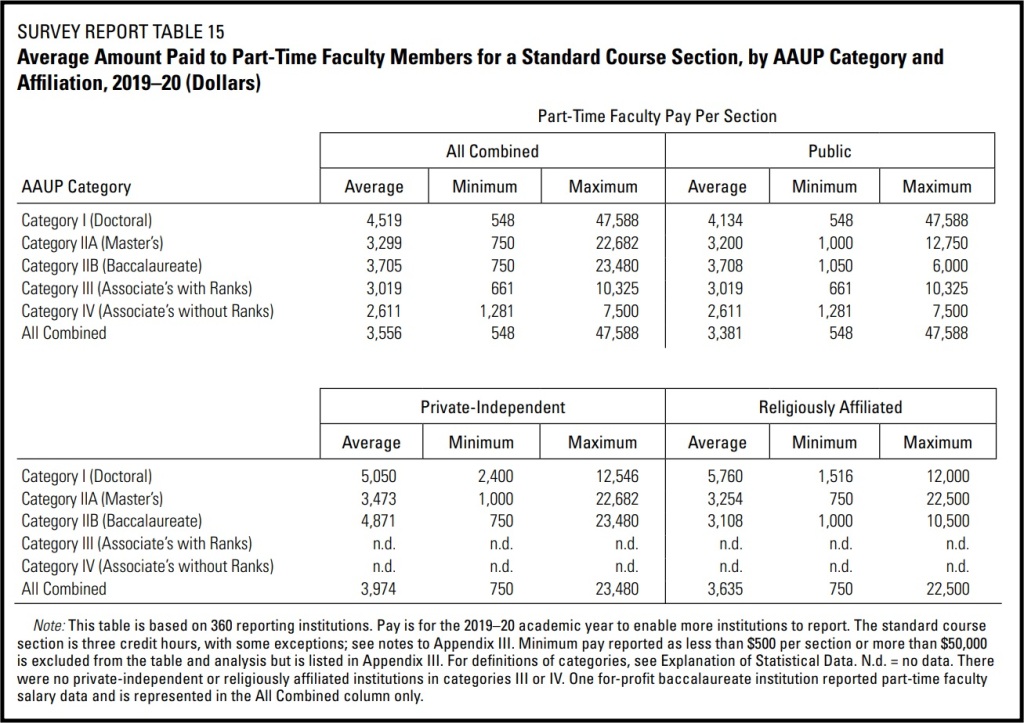Late last month, the American Association of University Professors (AAUP) released its Annual Report on the Economic Status of the Profession for 2020–2021. It has been published in the AAUP’s Bulletin and is available to download on its website.
This report now represents the most authoritative and up-to-date information we have about the basic employment conditions of college faculty members in the United States.
We need to talk about this report because Americans have many misconceptions about the lives of college professors. These misconceptions are encouraged by cynical rhetoric from politicians and pundits seeking to undermine our work. They also come from popular movies and television shows that depict professors enjoying lavish salaries and palatial campus offices.

These misconceptions can even come from employment websites, which tend to publish fabricated information. Glassdoor, for example, claims the average American adjunct professor makes more than $50,000 per year, and ZipRecruiter claims the same figure is $67,000. Such salaries would hardly be extravagant by middle-class standards in most cities. But in reality, a typical adjunct professor can expect to make only about half that much—with no benefits—if they can get full-time work at all.
Worse still, public misconceptions are not necessarily challenged by the behavior of tenured faculty members at elite research universities, who lead our professional associations and represent us on the public stage. So it’s important to highlight some of the data in this report.
First, the AAUP’s report shows that the typical American college professor today is an adjunct. In other words, part-time contingent faculty members (professors hired by the course and considered “part-time” workers no matter how many courses they teach) are the largest single class of college professor.
By how wide a margin? According to data from 2019, the AAUP report says, 42.9% of American college professors are part-time contingent faculty members. That means the adjunct workforce is significantly larger than the combined number of tenured professors (26.5% of the faculty) or tenure-track professors still seeking tenure (10.5%). It is also more than twice the number of full-time contingent faculty members, such as “visiting” professors or “professors of practice” (20.0%).
It’s important to note that these figures do not include graduate student workers. We’re talking just about professors, not TAs.

Here’s another way to look at those figures: Across American higher education, adjuncts outnumber tenure-seeking junior professors four to one. That means adjunct professors, more than new professors who will one day have tenure, represent the future of the professoriate.
Even among the elite of American universities—doctorate-granting institutions that pride themselves on using the tenure system to protect the freedom of their researchers—adjuncts are nearly one third of the faculty, outnumbering tenure-seeking professors two to one.
There is an important bright spot in these numbers, however. The AAUP report finds that the proportion of the faculty holding full-time contingent appointments—with benefits and better pay than adjuncts get—has been increasing over the last decade and a half.
In 2006, full-time contingent workers were 15.5% of the workforce; as of 2019, they are 20.0%, with steady growth in their relative numbers since 2009. Making inquiries on relevant campuses, the AAUP’s researchers “found that one reason for the shift is that some institutions are taking actions to improve the working conditions for contingent faculty members.” Hooray.
But for now, it’s important to recognize another key element of the AAUP report: professors’ compensation. For adjuncts, the news is unsurprisingly grim.
The data on adjunct pay are more limited than the data for other kinds of professors. But according to information from 360 American institutions in 2019-2020, the average pay of part-time faculty members is $3,556 per course.
[Edit: Let’s be clear—many adjuncts never see wages that are anywhere close to this national mean. Please consult the data Erin Bartram collected for the 2019-2020 academic year. Adjunct instructors across the U.S. and Canada volunteered to reveal their pay for more than 700 courses. Some made well under $2,000 per course.]
Furthermore, only 1.6% of colleges offer all their part-time professors medical benefits, and only 7.1% offer all their part-time professors any retirement benefits.


To underscore what this means for U.S. higher education in 2021:
The typical American college professor (i.e., an average member of the most numerous class of American professors) makes $3,556 per course with no healthcare or other benefits.
If you aren’t familiar with how colleges work behind the scenes, it may be difficult to guess what this means for adjuncts’ annual wages. In fact, adjuncts often have very unreliable employment—being hired and (unofficially) laid off unpredictably from semester to semester. Because of this, as well as other factors, accurate annual wage data still simply don’t exist for adjuncts.
But nationwide, most college professors would recognize teaching three or four courses per regular academic semester as a full-time workload. If we add two summer courses for the sake of a year-round number, that means the typical college professor would be lucky to make $35,560 per year, and often might expect to make more like $21,336—that is, during the years when they could cobble together full-time teaching work at different institutions.
Now, some adjuncts do work on a truly part-time basis, teaching a course here and there on the side while maintaining another full-time career that allows them such fripperies as, say, going to the dentist. That is what many college administrators use as a justification for the shabby way they treat their professors.
But the reality is that many adjuncts today depend exclusively or primarily on their income as college teachers. This is what they face. This is how the typical college professor is rewarded for their work as they keep American higher education going.
If you’re interested in the current state of U.S. higher education, there’s a lot more information where this came from—including salary information for tenure-track professors and (ahem) college presidents, among many other topics.

Everywhere needs to pay more. Finished a post doc in spring 2020 and got a full time visiting position in pa for 61k (which is 10k higher than post doc was) which i thought was decent (parents thoughy professors make $90k+ …), sadly that was terminated this year so I was back om the market and was surprised some state universities, pay in the lower 40s full time TT, and community colleges can pay higher, took a paycut for a cc that seemed stable, state supported, and pays a ton gor overtime and overloaf so should make more than I presently was.
But imo everywhere needs to pay more I think 60$k should be minimum for all.
The 40k schools had faculty justifying it because the regions have low cost of living which IMO is outdated thinking considering we millenials now carry student debt, are usually single, would have cars, and trying to establish some type of emergency savings etc. And also rents are increasing, 40k only goes so far, especially when youre forced to put some of it to retirement and you cant live comfortably like that unmarried. To me it was no surprise seeing schools repost the same positions years in a row and struggle to keep people hired. And also paying less than the govt advises for stem post docs just seemed laugahble and rude.
LikeLike
I used to know quite a few people who taught at the college level as adjunct professors but they actually didn’t work at 1 single University. Yesterday. They were driving all around town every day of the week teaching a class at this place and a class at another place and a class at another place with no benefits lousy pay and cars that were barely functional from all the miles they put on them. And no chance of ever getting tenure. Many of these were female professors . The respect that they received for their knowledge was a dismal. And it makes me wonder how my $4,000 yearly tuition at DePaul University in 1979 ballooned to nearly $50,000. It’s not professor salaries or grad students, that’s for sure!
LikeLike
Back in the early 70’s I taught a course as an adjunct. Paid only $1500 then. It was a sideline, but clearly not worth it. The problems in higher ed run deep. Time for major reform. Including low cost pathways thru remote/online learning for many (most) students.
LikeLike
David, I think the proliferation of online instruction is only deepening the employment crisis by rendering instructors even more expendable (and their labor more invisible) in the eyes of administrators, students, and politicians.
LikeLike
It is a market signal telling us most of the subjects in the university is worthless. If a professor can find a decent job in the industry, why would he accept such a low paid? If a even professor can’t find a decent job in his field, why the students should waste time learning those unemployable skills?
On the other hand, professors in medical school or law school, or high-tech fields, they never have the low wage problem. If the colleges don’t pay them enough, they can simply go to work in the industry.
LikeLike
The name for this sentiment is “knowing the price of everything and the value of nothing.” But you’re right about one thing: The working conditions of contingent faculty members do show that our colleges and universities hold the subjects we teach in contempt.
LikeLike
Another aspect of the shift away from tenured and tenure track faculty is the increased power of the administrative structure over the direction of the institution and the content of the curriculum. The institution’s administration does not possess the same instincts and drives to seek the truths of reality. They are by nature of their “professional” status interested more in the perpetuation of the institution–and thus their livelihood and community status than in enhancing the bodies of knowledge and understanding of ourselves and the world around us.
And, sadly, we are approaching POGO’s world where a “fact” is whatever POGO says it is!! SIGH!!
LikeLike
I was a US college adjunct for 22 years and finally left the country for good 5 years ago before I sank completely underwater. The facts here say a lot, but the core truth is that most adjuncts make LESS THAN MINIMUM WAGE. https://jackdempseywriter.wordpress.com/2013/04/15/college-adjunct-professors-minimum-wage-you-be-the-judge/
LikeLike
[…] “The typical college professor would be lucky to make $35,560 per year, and often might expect to … — a look at the AAUP’s Annual Report on the Economic Status of the Profession (via Sara Protasi) […]
LikeLike
[…] Jonathan Wilson, “The Typical US College Professor Makes $3,556 Per Course.” […]
LikeLike